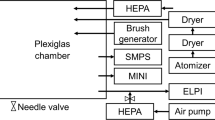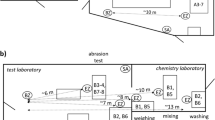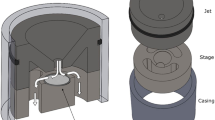Abstract
This paper reports a study of the dispersion of manufactured nano-objects (MNOs) through the air, both in time and space, during the use of two commercially available nano-spray products and comparable products without MNOs. The main objective was to identify whether personal exposure can occur at a greater distance than the immediate proximity of the source (>1 m from the source), that is, in the “far field” (bystanders), or at a period after the emission occurred (re-entry). The spray experiments were conducted in an experimental room with well-controlled environmental and ventilation conditions (19.5 m3). The concentration of MNOs was investigated by measuring real-time size distribution, number, and active surface area concentration. For off-line analysis of the particles in the air, samples for scanning/transmission electron microscopy and elemental analysis were collected. The release of MNOs was measured at ∼30 and 290 cm from the source (“near field” and “far field”, respectively). For all four spray products, the maximum number and surface area concentrations in the “near field” exceeded the maximum concentrations reached in the “far field”. At 2 min after the emission occurred, the concentration in both the “near field” and “far field” reached a comparable steady-state level above background level. These steady-state concentrations remained elevated above background concentration throughout the entire measurement period (12 min). The results of the real-time measurement devices mainly reflect the liquid aerosols emitted by the spray process itself rather than only the MNO, which hampers the interpretation of the results. However, the combination of the off-line analysis and the results of the real-time devices indicates that after the use of nano-spray products, personal exposure to MNOs can occur not only in the near field, but also at a greater distance than the immediate proximity of the source and at a period after emission occurred.
This is a preview of subscription content, access via your institution
Access options
Subscribe to this journal
Receive 6 print issues and online access
$259.00 per year
only $43.17 per issue
Buy this article
- Purchase on Springer Link
- Instant access to full article PDF
Prices may be subject to local taxes which are calculated during checkout






Similar content being viewed by others
References
Maynard AD, Aitken RJ, Butz T, Colvin V, Donaldson K, Oberdörster G et al. Safe handling of nanotechnology. Nature 2006; 444: 267–269.
Nemmar A., Vanbilloen H., Hoylaerts MF, Hoet PH, Verbruggen A., Nemery B . Passage of intratracheally instilled ultrafine particles from the lung into the systemic circulation in hamster. Am J Resp Crit Care 2001; 164: 1665–1668.
Oberdörster G., Sharp Z., Atudorei V., Elder A., Gelein R., Lunts A. et al. Extrapulmonary translocation of ultrafine carbon particles following whole-body inhalation exposure of rats. J Toxicol Environ Health 2002; 65: 1531–1543.
Elder A., Gelein R., Silva V., Feikert T., Opanashuk L., Carter J et al. Translocation of inhaled ultrafine manganese oxide particles to the central nervous system. Environ Health Persp 2006; 114: 1172–1178.
Oberdörster G., Sharp Z., Atudorei V., Elder A., Gelein R., Kreyling W et al. Translocation of inhaled ultrafine particles to the brain. Inhal Toxicol 2004; 16: 437–445.
Takenaka S, Karg E., Roth C., Schulz H., Ziesenis A., Heinzmann U et al. Pulmonary and systemic distribution of inhaled ultrafine silver particles in rats. Environ Health Persp 2001; 109 (Supp 4): 547–551.
Schneider T., Brouwer DH., Koponen IK., Jensen KA, Fransman W., Van Duuren-Stuurman B et al. Conceptual model for assessment of inhalation exposure to manufactured nanoparticles. J Expo Sci Env Epid 2011; 21: 450–463.
Norgaard AW, Jensen KA, Janfelt C., Lauritsen FR, Clausen PA, Wolkoff P. . Release of VOCs and particles during use of nanofilm spray products. Environ Sci Technol 2009; 43: 7824–7830.
Quadros M E, Marr LC . Silver nanoparticles and total aerosols emitted by nanotechnology-related consumer spray products. Environ Sci Technol 2011; 45: 10713–10719.
Chen BT, Afshari A., Stone S., Jackson M., Schwegler-Berry D., Frazer DG et al. Nanoparticles-containing spray can aerosol: characterization, exposure assessment, and generator design. Inhal Toxicol 2010; 22: 1072–1082.
Nazarenko Y., Han T. W., Lioy P. J., Mainelis G. . Potential for exposure to engineered nanoparticles from nanotechnology-based consumer spray products. J. Expo Sci Env Epid 2011; 21: 515–528.
Hagendorfer H., Lorenz C., Kaegi R., Sinnet B., Gehrig R., Goetz NV et al. Size-fractionated characterization and quantification of nanoparticle release rates from a consumer spray product containing engineered nanoparticles. J Nanopart Res 2010; 12: 2481–2494.
Lorenz C., Hagendorfer H., Von Goetz N., Kaegi R., Gehrig R., Ulrich A et al. Nanosized aerosols from consumer sprays: experimental analysis and exposure modeling for four commercial products. J Nanopart Res 2011; 13: 3377–3391.
Delmaar JE, Bremmer HJ The ConsExpo spray Model. Modeling and experimental validation of the inhalation exposure of consumers to aerosols from spray cans and trigger sprays. RIVM report 2009 320104005/2009. Available at http://www.rivm.nl/bibliotheek/rapporten/320104005.pdf.
Seipenbusch M., Binder A., Kasper G . Temporal evolution of nanoparticle aerosols in workplace exposure. Ann Occup Hyg 2008; 52: 707–716.
van Duuren-Stuurman B, Vink SR, Verbist KJM, Heussen HGA, Brouwer DH, Kroese DED et al. Stoffenmanager nano version 1.0: a web-based tool for risk prioritization of airborne manufactured nano objects. Ann Occup Hyg 2012; 56: 525–541.
Acknowledgements
We thank the Ministry of Social Affairs and Employment for funding and RJ Schimmel and R Engel for their assistance during the experiments.
Author information
Authors and Affiliations
Corresponding author
Ethics declarations
Competing interests
The authors declare no conflict of interest.
Rights and permissions
About this article
Cite this article
Bekker, C., Brouwer, D., van Duuren-Stuurman, B. et al. Airborne manufactured nano-objects released from commercially available spray products: temporal and spatial influences. J Expo Sci Environ Epidemiol 24, 74–81 (2014). https://doi.org/10.1038/jes.2013.36
Received:
Accepted:
Published:
Issue Date:
DOI: https://doi.org/10.1038/jes.2013.36
Keywords
This article is cited by
-
Characteristics of phthalate concentrations in propellant- and trigger-type consumer spray products
Air Quality, Atmosphere & Health (2024)
-
Slow lung clearance and limited translocation of four sizes of inhaled iridium nanoparticles
Particle and Fibre Toxicology (2017)
-
Online characterization of nano-aerosols released by commercial spray products using SMPS–ICPMS coupling
Journal of Nanoparticle Research (2015)



